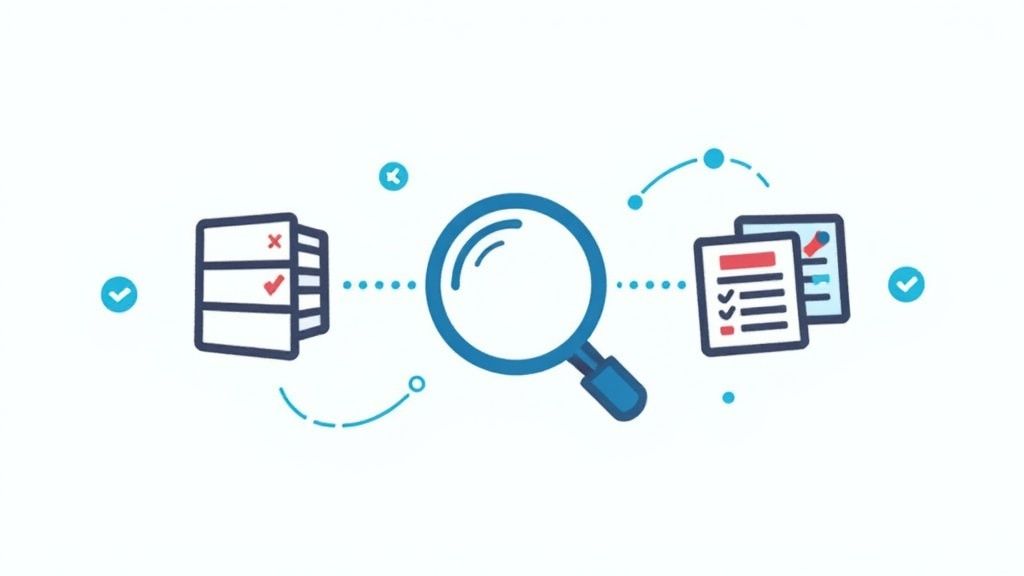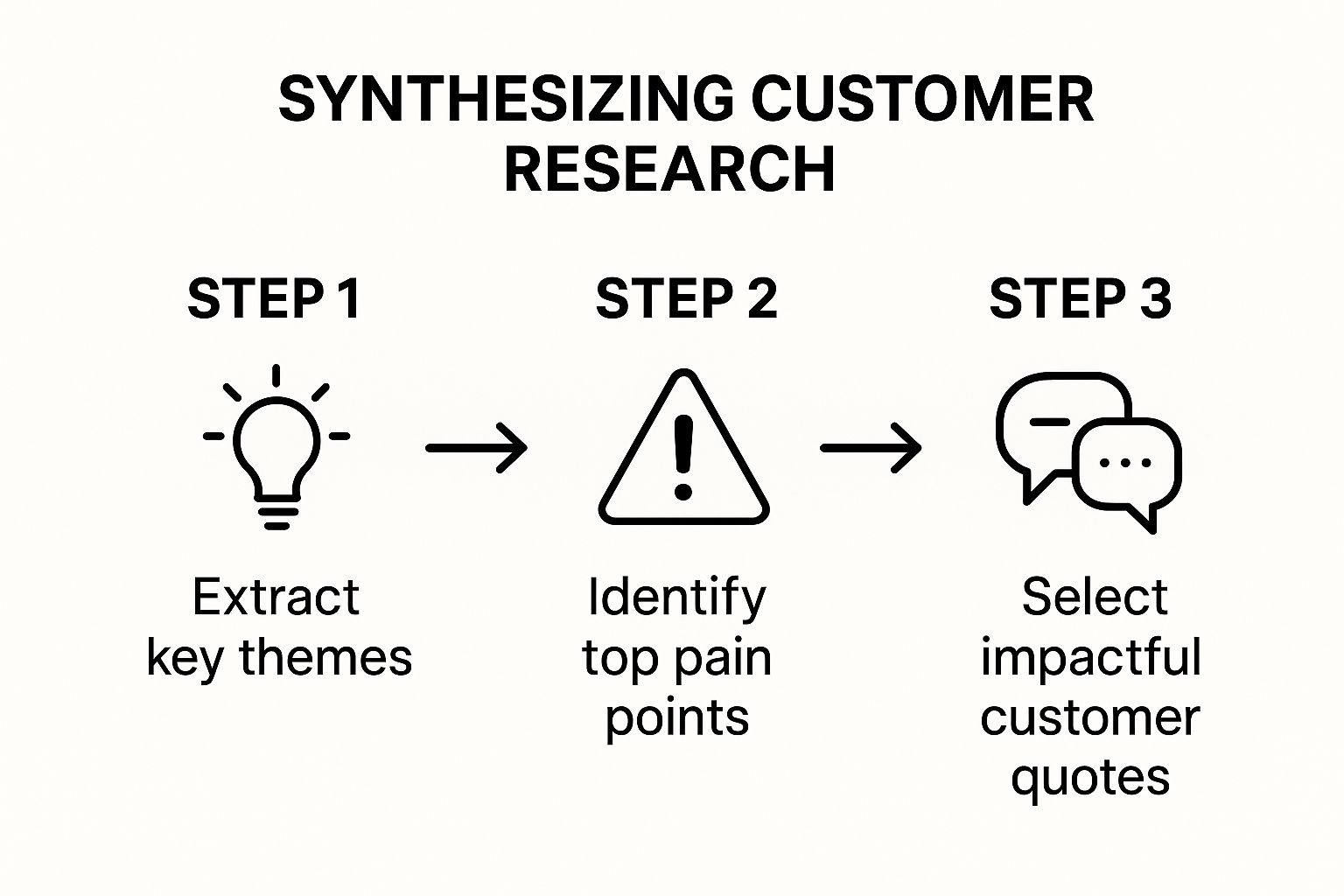How to Create Buyer Personas That Get Results
Creating buyer personas is all about painting a detailed, semi-fictional picture of your ideal customers. This isn't just guesswork; it's a process grounded in real data and solid research. By digging into their goals, pain points, and buying behaviors, you can craft a tool that guides everything from marketing and sales to product development.
Why Vague Personas Are Killing Your Marketing

Let’s be honest. We’ve all seen them: personas like "Marketing Mary," a 35-year-old manager who "loves coffee and browsing LinkedIn." The alliteration is cute, but these one-dimensional profiles do more harm than good. They give you a false sense of knowing your customer, which leads to generic messaging and strategies that fall flat.
When your personas are shallow, your marketing is too. Campaigns miss the mark because they aren't speaking to genuine needs. Ad spend gets torched on broad demographics instead of specific motivations. And product teams end up building features for imaginary problems, leading to dismal adoption rates.
Moving Beyond the Checklist
The real problem is treating persona creation like a box-checking exercise instead of a deep, strategic dive. A truly useful buyer persona isn’t just a collection of demographic data points; it’s a story about a real person’s challenges, motivations, and aspirations.
“Buyer Personas are archetypes of real buyers that allow marketers to craft strategies to promote products and services to the people who might buy them.”
This means you need to shift your focus from what your ideal customer is (their job title, their age) to why they make decisions. What triggers their search for a new tool? What does a huge win look like in their role? Answering these questions turns a flat caricature into a powerful strategic asset.
The Real Cost of Generic Profiles
Generic personas create expensive misalignments across your entire company. Marketing, sales, and product teams end up working from different playbooks because there's no shared, authentic understanding of who the customer really is.
This disconnect has tangible consequences:
- Ineffective Content: Your blog posts, emails, and ads fail to connect because they’re talking about surface-level topics, not the deep-seated problems your customers face.
- Wasted Ad Spend: Without a clear picture of your customer’s journey, you’re just throwing money at channels hoping something sticks.
- Poor Sales Alignment: Sales reps have a tough time building rapport when their talking points don't line up with the prospect's actual day-to-day challenges.
Ultimately, a vague persona is a compass pointing nowhere. This guide will show you how to build data-backed personas that act as a true north for every decision, ensuring your teams are united in their mission to win over your ideal customer.
Gathering the Raw Materials for Your Personas

This is where the real work begins. Great personas aren't just dreamed up in a conference room; they're built brick by brick with solid data. Think of yourself as a detective gathering clues. Before you can paint a picture of your ideal customer, you need to collect the raw intelligence that defines who they are, what they need, and why they act the way they do.
The old way of creating personas was mostly qualitative, a creative exercise. Modern personas, however, are far more data-driven. We now blend behavioral analysis with statistical methods to group customers into clear, actionable segments. This approach is far more reliable and often uncovers surprising patterns you'd never find through guesswork alone.
Tapping into Your Internal Data Goldmine
Your first stop on this intelligence-gathering mission is your own backyard. You're likely sitting on a treasure trove of behavioral data right now. It’s time to dig in and see what stories your existing systems can tell you about your most valuable customers.
Look for patterns in a few key places:
- Your CRM: Who are your best customers? Pinpoint their job titles, company sizes, and industries. What common pain points or success stories are your sales team logging in their notes?
- Google Analytics: Dive into the demographics and locations of your users. More importantly, trace the paths they take. Which blog posts or landing pages are the MVPs for converting traffic?
- Sales Team Feedback: Your sales reps are on the front lines every single day. They have unfiltered insights into the real objections, questions, and motivations that drive your prospects. Schedule a few quick chats to tap into this invaluable knowledge.
This initial dive into your own data helps you form a solid hypothesis about who your personas are. It gives you a strong foundation before you start looking for answers outside your own walls. If you want to get a head start on organizing this information, check out our guide on effective market segmentation strategies.
A persona built on guesswork is just a fictional character. A persona built on interviews, surveys, and behavioral data is a strategic asset. Always validate your internal assumptions with direct feedback from your target audience.
Preparing for Customer Conversations
Once you have a handle on your internal data, it's time to talk to actual human beings. This is the step that breathes life and personality into your personas, turning them from data points into relatable profiles. Your best tools for this are customer interviews and targeted surveys.
For interviews, ditch the "yes or no" questions. You want stories. Instead of asking, "Is our price fair?" try something like, "Can you walk me through the budget approval process for a tool like ours?" This open-ended approach gets people talking.
For surveys, aim for a mix of quantitative data (like ratings on a scale of 1-10) and qualitative insights from optional text boxes. This blend of hard numbers and personal stories is what will ultimately make your personas feel real, relatable, and ready for action.
Uncovering Deep Customer Insights Through Research
So you’ve gathered a mountain of data. Now what? Piles of raw information are useless until you find the human story hidden inside. This is where the real work begins—transforming that data into powerful insights that breathe life into your buyer personas.
We're moving beyond surface-level answers to get at the real motivations, daily frustrations, and ultimate goals of your customers.
To do this right, you need to blend different research methods to paint a complete picture. Personas are built on a foundation of both qualitative and quantitative data. One fintech app in 2021 learned this lesson firsthand. After surveying current and potential customers, they discovered users had no idea what the differences were between their product tiers, which led to serious underutilization.
By mapping out detailed personas from that data, they were able to personalize their marketing and onboarding. The result? A predicted 29% revenue growth and a 15% increase in new customer acquisition. You can learn more about the findings from this market success blueprint.
Synthesizing all this information is how you turn abstract data points into a relatable human narrative. The visual below breaks down how you can approach this process.

This simple workflow helps you drill down from broad patterns to the specific, memorable details that make your personas truly useful.
To really get a 360-degree view, you'll want to pull from multiple data sources. Relying on just one method, like surveys, can give you a skewed perspective. The table below outlines a few key sources and what you can expect to learn from each.
Data Sources for Comprehensive Persona Research
| Data Source | Type of Data | Key Insights Gained | Example Question/Metric |
|---|---|---|---|
| Customer Interviews | Qualitative | Motivations, goals, specific language, emotional context, detailed workflows. | "Walk me through the last time you had to solve [problem]. What was that like?" |
| Surveys | Quantitative & Qualitative | Demographic data, priority ranking, satisfaction scores, common challenges. | "On a scale of 1-10, how critical is [feature] to your daily work?" |
| Product Analytics | Quantitative | User behavior, feature adoption, friction points in the user journey. | What percentage of new users complete the onboarding checklist? |
| Sales & Support Calls | Qualitative | Common objections, pre-sale questions, post-sale frustrations, recurring issues. | "What's the one thing you wish the product could do that it can't today?" |
Combining insights from these different channels is what gives your personas depth and accuracy. Product analytics might show you where users are dropping off, but a support call transcript will tell you why.
The Art of the Customer Interview
This is where your personas get their soul. Customer interviews aren't about validating what you already think—they’re about being surprised. You want to hear your customers' stories, in their own words, using the exact language they use to describe their day-to-day headaches.
Forget closed questions. To get beyond canned, polite responses, you need open-ended questions that encourage storytelling.
Instead of asking, "Do you find our reporting feature useful?" try this: "Walk me through how you prepare for your end-of-month reporting meeting." The second version prompts a narrative, revealing context, workarounds, and frustrations you’d never uncover otherwise. Your goal is always to find the "why" behind the "what."
A persona built on guesswork is a fictional character. A persona built on interviews, surveys, and behavioral data is a strategic asset. Always validate your internal assumptions with direct feedback.
Designing Surveys That Deliver Actionable Data
While interviews give you depth, surveys deliver breadth. They’re your chance to quantify the themes you uncovered in those one-on-one chats and see how widespread they really are.
The trick to a great survey is balancing multiple-choice questions with a few golden open-ended text fields.
- Quantitative Questions: Use scales (e.g., "On a scale of 1 to 10, how important is X?") to measure priorities and spot trends across your user base.
- Qualitative Questions: Include optional free-text fields like, "What's the single biggest challenge you face in your role?" This is where you'll capture the raw, unfiltered customer voice.
This mix gives you both statistical confidence and the rich, emotional context you need to build a persona that feels real. For startups trying to scale this process, exploring different market research tools can be a game-changer.
Spotting Themes and Compelling Quotes
Okay, you've collected a ton of interview transcripts and survey responses. Time to put on your detective hat.
Start by highlighting recurring phrases, pain points, and stated goals. As you read through everything, group similar comments together. You'll quickly start to see the most significant patterns emerge—these will form the core of your persona's story.
Most importantly, keep an eye out for direct quotes that are especially insightful or emotionally charged. A single powerful quote can summarize a major challenge far better than a boring bullet point ever could.
A line like, "I spend half my Monday just trying to sync data between three different tools," instantly makes a persona's struggles feel urgent and real. These quotes are the secret ingredient to creating documents your team will actually remember and use.
Building and Documenting Your Buyer Personas
Alright, you've done the hard work of research. Now comes the fun part: turning all those raw notes, transcripts, and data points into a living, breathing document. This is where you assemble everything into a clear profile that your sales, marketing, and product teams can actually use.
The goal here is to create a strategic tool, not just another PDF that gathers digital dust in a forgotten folder. We're moving beyond basic demographics to build a character sketch that feels real—because if the character isn't believable, the story falls apart.
From Data Points to Human Stories
The first thing to do when documenting your personas is to look for the narrative. Sift through your interview notes, survey results, and analytics to find the common thread. What’s the shared journey your customers were on before they found you? This story becomes the backbone of your persona.
Start by giving your persona a memorable, alliterative name. Think "Startup CEO Sam" or "Product Manager Priya." It’s a simple trick, but it makes them way easier to talk about in meetings. Then, find a stock photo that feels right. These little humanizing details are surprisingly powerful in making a persona stick.
Now, let's flesh out the components that actually matter for a SaaS company. These are the elements that get to the why behind their behavior.
- Goals & Motivations: What does a "win" look like for them at work? List their main professional goals (e.g., "Increase user retention by 15%") and their personal ambitions in their role (e.g., "Be seen as the go-to innovator on my team").
- Challenges & Frustrations: This is where you capture their biggest headaches. Use direct quotes from your interviews to make the pain points hit harder. "I waste hours every week manually exporting and formatting reports" is a thousand times more impactful than a generic bullet point.
- Watering Holes: Where do they hang out online to get information? List the specific blogs, podcasts, influencers, and communities they actually trust. This isn't just fluff; it's a goldmine for your content and partnership strategy.
Structuring Your Persona Document
To make sure your persona document gets used, it has to be clean, scannable, and focused. Ditch the dense paragraphs. Use a mix of bullet points, short descriptions, and pull quotes to make the information easy to digest.
The most powerful persona documents tell a story. They combine hard data with direct customer quotes to create a profile that is both factually accurate and emotionally resonant. This is what turns a persona from a document into a decision-making tool.
A great persona template always includes a short bio or summary. This is a punchy, 1-2 sentence narrative that boils down who they are, what they do, and what’s keeping them up at night.
For example: "Priya is a dedicated Product Manager at a mid-sized SaaS company who is passionate about building user-centric features. She struggles to get clear, consolidated feedback from users and spends too much time chasing down data instead of focusing on strategy."
Finally, share it. A persona's value is directly tied to how often it’s brought up in marketing stand-ups, product roadmapping sessions, and sales calls. By building a document that is both insightful and incredibly easy to use, you ensure your buyer personas become a core part of your company's strategic conversations.
Putting Your Personas to Work Across the Business
 Let's be honest. A beautifully crafted buyer persona is completely useless if it just collects digital dust in a shared drive. All that research, all those interviews—it's all for nothing if you don't actually use it.
Let's be honest. A beautifully crafted buyer persona is completely useless if it just collects digital dust in a shared drive. All that research, all those interviews—it's all for nothing if you don't actually use it.
The real magic happens when your personas become the compass for your entire organization. They should guide decisions in marketing, shape conversations in sales, and challenge assumptions in product development. This is where your research stops being a document and starts being an engine for growth.
Think of your personas as the bridge between your product's slick features and your customer's messy, real-world problems. They make sure every blog post, every email, and every new feature is laser-focused on solving a specific need you've already validated.
This isn’t just theory. The numbers back it up. Organizations that actually use their personas see a 19% rise in revenue growth and a 14% increase in client retention. Even more telling, email campaigns that are targeted using buyer personas generate 18 times more revenue than generic email blasts. That's a massive impact on the bottom line.
Activating Personas in Your Marketing Funnel
Your new personas should immediately shake up your content and demand-gen strategy. No more guessing what topics might resonate. Now you can build a content calendar that directly answers the documented goals and challenges of "Product Manager Priya" or "Startup CEO Sam."
This targeted approach bleeds into every marketing channel:
- Content Strategy: Create blog posts, guides, and webinars that tackle the exact questions your personas are asking. If Priya is constantly struggling with sorting user feedback, a guide on that topic is a guaranteed home run.
- Website Messaging: Go refine your homepage copy. Tweak your landing pages. You should be speaking directly to your persona’s primary pain points using the exact language you captured in your interviews.
- Email Campaigns: Segment your email list by persona and deliver nurturing sequences that feel personal and relevant. This extra effort pays off—persona-driven emails see a 14% higher click-through rate.
These personas are absolutely essential when it comes to implementing effective lead generation best practices. They turn broad, fuzzy strategies into precise, targeted actions.
Your persona should be a living, breathing part of your daily workflow. In every meeting, someone should be asking, "How does this decision help Priya?" or "Is this what Sam is really looking for?" That simple question keeps everyone relentlessly focused on the customer.
Empowering Sales and Product Teams
This goes way beyond marketing. Your buyer personas are a critical asset for your sales and product teams, too.
For the sales team, they're basically a cheat sheet for building instant rapport and qualifying leads more effectively. A rep can glance at a persona and immediately understand a prospect's likely challenges, tailoring their pitch on the fly.
And for product teams? Personas are the ultimate reality check. They ensure new features are being built to solve real-world problems, not just to chase the latest shiny trend. This customer-first approach is also the bedrock of creating better user experiences from day one. In fact, a deep understanding of your customer is fundamental to successful customer onboarding strategies that keep churn at bay.
Ultimately, when you integrate personas across your entire business, you align every single department around a shared vision of the customer. And that alignment is where you’ll see the most dramatic results—from shorter sales cycles to happier, more loyal users.
A Few Common Questions About Building Buyer Personas
Whenever I kick off a persona project with a new team, the same handful of questions always pop up. Getting these sorted out right from the start saves a ton of headaches down the road and makes sure the final profiles are actually useful, not just another document collecting dust.
Let's tackle those common hurdles head-on so you can keep your project moving.
How Many Buyer Personas Should We Actually Create?
This is always the first question, and there’s no magic number. But from my experience, the sweet spot for most businesses is 3-5 core personas. It’s enough to cover your key customer segments without overwhelming your team.
If you’re just getting started, don’t try to boil the ocean. Seriously. Just focus on your single most important customer profile—the one that represents your bread-and-butter. You can always expand later.
The main thing is to avoid creating so many personas they all start to blur together. If you're drafting two personas and their goals and challenges are nearly identical, that's your cue to merge them.
What’s the Single Biggest Mistake to Avoid?
Easy. Building your personas based on what you think you know instead of what your customers actually tell you. It’s so tempting to get the team in a room and brainstorm what a customer wants, but those are just educated guesses.
A persona built on guesswork is a fictional character. A persona built on interviews, surveys, and real data is a strategic asset.
You have to validate every assumption with direct feedback from your audience. Without hearing it from them, your personas are hollow. This is the one mistake that separates a document that guides company strategy from one that gets forgotten in a week.
How Often Should We Update Our Personas?
This isn't a "one and done" project. Markets shift, customer needs evolve, and new tech changes how people work. Your personas are living documents, and they need a check-up to stay relevant.
A good rule of thumb is to formally review and refresh your personas at least once a year.
Beyond that, you should pull them out anytime there's a major shift in your world, like when you’re:
- Launching a major new product or feature
- Pushing into a new market or region
- Noticing a big change in how customers are behaving
These moments are the perfect trigger to ask, "Do we still understand who we're building for?"
What’s the Difference Between a Buyer Persona and a Target Market?
This one trips a lot of people up, but the distinction is crucial for getting your messaging right.
A target market is broad and demographic. Think: "SaaS companies in North America with 50-200 employees." It’s the wide net you cast to define who you could potentially sell to.
A buyer persona, on the other hand, zooms in on a specific, semi-fictional individual within that market. It gives them a name, a story, and a personality. It dives deep into their goals, daily frustrations, and what motivates them. It turns a faceless group into a person your team can actually connect with, which is way more powerful for marketing, sales, and product development.
Ready to stop guessing and start building landing pages your ideal customers will love? With Pages.Report, you can analyze over 368 successful SaaS products to uncover proven design patterns and copywriting strategies. Transform insights into high-converting pages today. Explore our collection at https://pages.report.
